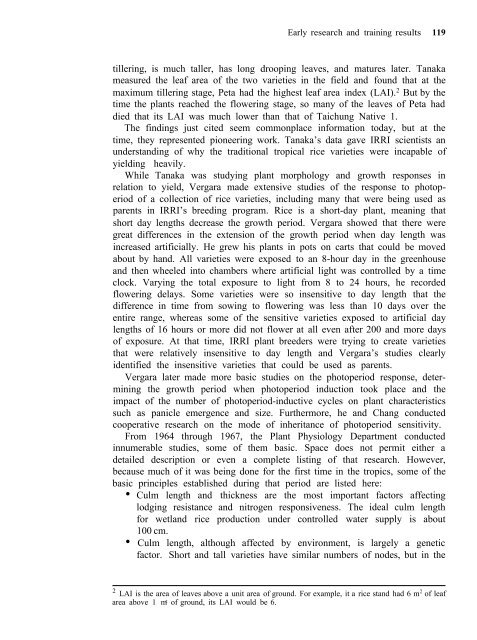An adventure in applied science - IRRI books - International Rice ...
An adventure in applied science - IRRI books - International Rice ...
An adventure in applied science - IRRI books - International Rice ...
- No tags were found...
Create successful ePaper yourself
Turn your PDF publications into a flip-book with our unique Google optimized e-Paper software.
Early research and tra<strong>in</strong><strong>in</strong>g results 119tiller<strong>in</strong>g, is much taller, has long droop<strong>in</strong>g leaves, and matures later. Tanakameasured the leaf area of the two varieties <strong>in</strong> the field and found that at themaximum tiller<strong>in</strong>g stage, Peta had the highest leaf area <strong>in</strong>dex (LAI). 2 But by thetime the plants reached the flower<strong>in</strong>g stage, so many of the leaves of Peta haddied that its LAI was much lower than that of Taichung Native 1.The f<strong>in</strong>d<strong>in</strong>gs just cited seem commonplace <strong>in</strong>formation today, but at thetime, they represented pioneer<strong>in</strong>g work. Tanaka’s data gave <strong>IRRI</strong> scientists anunderstand<strong>in</strong>g of why the traditional tropical rice varieties were <strong>in</strong>capable ofyield<strong>in</strong>g heavily.While Tanaka was study<strong>in</strong>g plant morphology and growth responses <strong>in</strong>relation to yield, Vergara made extensive studies of the response to photoperiodof a collection of rice varieties, <strong>in</strong>clud<strong>in</strong>g many that were be<strong>in</strong>g used asparents <strong>in</strong> <strong>IRRI</strong>’s breed<strong>in</strong>g program. <strong>Rice</strong> is a short-day plant, mean<strong>in</strong>g thatshort day lengths decrease the growth period. Vergara showed that there weregreat differences <strong>in</strong> the extension of the growth period when day length was<strong>in</strong>creased artificially. He grew his plants <strong>in</strong> pots on carts that could be movedabout by hand. All varieties were exposed to an 8-hour day <strong>in</strong> the greenhouseand then wheeled <strong>in</strong>to chambers where artificial light was controlled by a timeclock. Vary<strong>in</strong>g the total exposure to light from 8 to 24 hours, he recordedflower<strong>in</strong>g delays. Some varieties were so <strong>in</strong>sensitive to day length that thedifference <strong>in</strong> time from sow<strong>in</strong>g to flower<strong>in</strong>g was less than 10 days over theentire range, whereas some of the sensitive varieties exposed to artificial daylengths of 16 hours or more did not flower at all even after 200 and more daysof exposure. At that time, <strong>IRRI</strong> plant breeders were try<strong>in</strong>g to create varietiesthat were relatively <strong>in</strong>sensitive to day length and Vergara’s studies clearlyidentified the <strong>in</strong>sensitive varieties that could be used as parents.Vergara later made more basic studies on the photoperiod response, determ<strong>in</strong><strong>in</strong>gthe growth period when photoperiod <strong>in</strong>duction took place and theimpact of the number of photoperiod-<strong>in</strong>ductive cycles on plant characteristicssuch as panicle emergence and size. Furthermore, he and Chang conductedcooperative research on the mode of <strong>in</strong>heritance of photoperiod sensitivity.From 1964 through 1967, the Plant Physiology Department conducted<strong>in</strong>numerable studies, some of them basic. Space does not permit either adetailed description or even a complete list<strong>in</strong>g of that research. However,because much of it was be<strong>in</strong>g done for the first time <strong>in</strong> the tropics, some of thebasic pr<strong>in</strong>ciples established dur<strong>in</strong>g that period are listed here:• Culm length and thickness are the most important factors affect<strong>in</strong>glodg<strong>in</strong>g resistance and nitrogen responsiveness. The ideal culm lengthfor wetland rice production under controlled water supply is about100 cm.• Culm length, although affected by environment, is largely a geneticfactor. Short and tall varieties have similar numbers of nodes, but <strong>in</strong> the2LAI is the area of leaves above a unit area of ground. For example, it a rice stand had 6 m 2 of leafarea above 1 m2 of ground, its LAI would be 6.

















